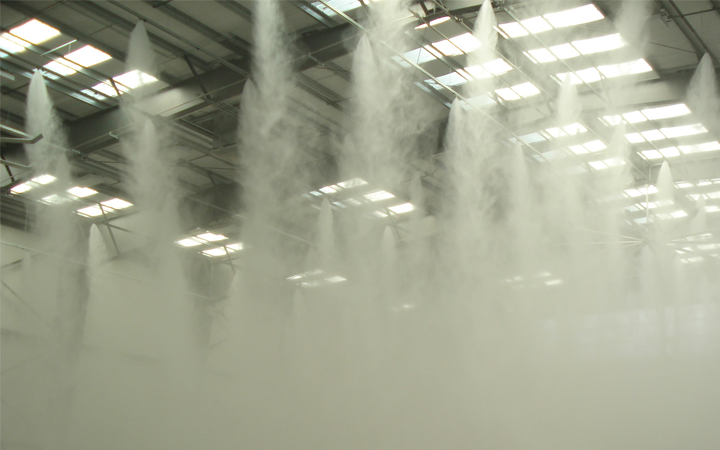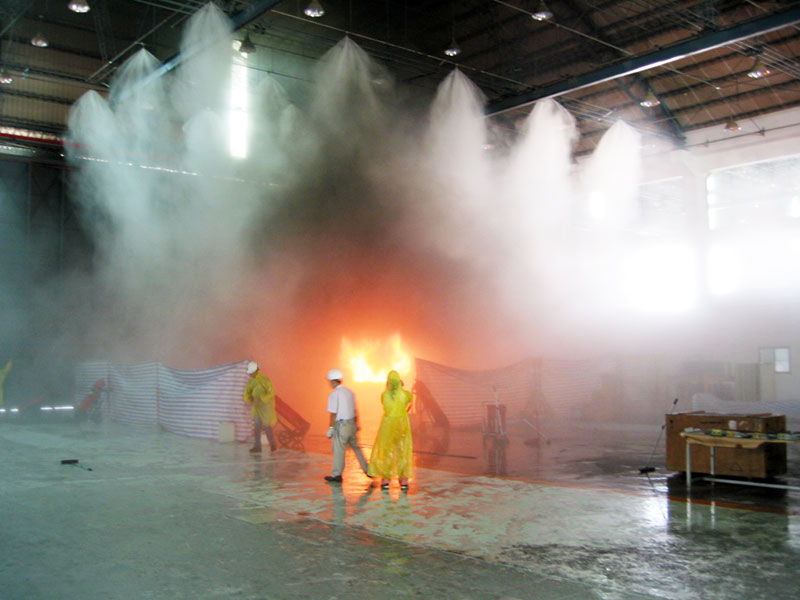

Water Mist System
Water mist fire suppression systems use very fine water droplets under pressure to control, suppress, or extinguish a fire by evaporating and cooling the flame and surrounding area. Water evaporation also creates an environment in which oxygen is displaced, which aids in the suppression of the fire.
A fire is controlled by high-pressure water mist penetrating it in liquid form, which causes cooling and evaporation.
It is incredibly effective, utilizing a lot less water than conventional sprinkler systems while yet performing at a similar or higher level.
Reduces water and fire damage to a minimum and doesn’t endanger life.
In comparison to a gaseous agent and conventional sprinkler systems, the usage of water mist fire suppression provides benefits including instant activation, great efficacy in putting out a variety of fires, and environmental friendliness with no toxicity issues.

What is the Water Mist System in fire protection?
A water mist system is a fire protection system that uses very fine water sprays. The small water droplets allow the water mist to control, suppress and extinguish fires by:
- cooling both the flame and surrounding gases by evaporation
- displacing oxygen by evaporation
- attenuating radiant heat by the small droplets themselves
Water mist system is a highly efficient fire protection solution, featuring unique nozzles that have been designed and rigorously tested to help protect against a wide range of fire risks.
The fine mist the system generates can extinguish a fire or limit its growth at an early stage, depending on the asset being protected.
Water mist systems help provide effective cooling and fire control on Class A fires, or assistance with extinguishing and preventing re-ignition on Class B or Class F fires.
The standard on water mist fire protection systems is NFPA 750. This standard protects life and property from fire through the standardization of design, installation, maintenance, and testing requirements for water mist fire suppression systems.
In that standard, they offer up low-pressure systems, intermediate, and high pressure. So low-pressure systems operate at around the same pressures that sprinkler systems will operate at.
Intermediate pressure is between 175 psi and 500 psi, and then high-pressure systems, 500 psi and up. There are differences between water mist systems and the droplet sizes that they produce, so typically the smaller the water droplet size the better it is at extinguishing a hot fire.
Larger droplets can work faster on lower temperature fires, but they all work for the systems that they’re approved for or listed for.
Nozzle & Water Types

Nozzles can be deluge type, water mist nozzle open all the time, and so when water flows to it, it will automatically go off, or automatic nozzles. So automatic nozzles would have a little thermal element in them, and when it gets heat to it, just like a sprinkler, it would burst and allow water to flow.
Variance in the water supply sources. Most water mist systems use two things. They use stainless steel pipe because don’t want it to rust in there.
Any rust or particulate in the piping system will get to the nozzles and gum them up, and we don’t want that to happen, and then just use tap water because we don’t want the water to become corrosive as it sits there and waits for a fire to happen.
Droplet Sizes
When looking at droplet sizes for water mist systems, one benchmark is that the droplets should be less than 1,000 microns in diameters. So for a system to be considered water mist, it has to have droplets smaller than 1,000 microns, which is the thickness of a dime.
So most sprinkler systems have droplet sizes produced around 5,000 microns, and water mist is less than 1,000.
Intermediate pressure water mist systems tend to produce around 300, maybe even 500-micron droplets, and then high-pressure systems around 50, maybe to 100, 150 microns in diameter.
So the concept with water mist is to take a given volume of water and break it down into smaller and smaller packets. When we do that, we increase the surface area of that water available to be exposed to the heat of the fire, so it can do certain things.
Why water mist system?

The NFPA 750 defines three pressure regions for water mist-generating technologies: low, intermediate and high-pressure systems.
The use of water mist fire suppression, when compared to the use of gaseous agents and traditional sprinkler systems, has revealed advantages such as:
- Immediate activation
- High efficiency in the suppression of a wide variety of fires
- Minimized water damage
- Environmentally sound characteristics
- No toxic problems
- As water mist both cools the fire and removes the oxygen, it results in quicker fire fighting
- The reduced amount of damage often means less downtime, resulting in much lower costs
High water mist system consistently delivers:
- Better penetration into the seat of the fire
- Superior coverage of the protected volume
- An improved cooling effect from better mixing of gases and high evaporation rate
- Lower overall system weight
- Less water consumption
The good news is AITO has capable technician that can possess the required abilities and information.


